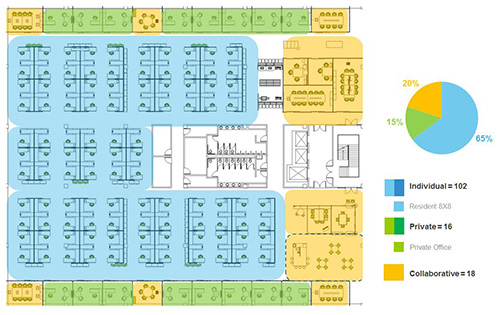The world is changing, rapidly. By 2025 it is projected that Millennials will occupy 70% of the workplace and as we all know, their expectations, work style and needs are a far cry from their predecessors. How can the workplace adapt? How can the future workplace provide collaboration and technology tools that are intuitive and seamlessly integrated into the space? How can space support collaboration and enhance communication, fostering the creativity and engagement that organizations need to innovate?
When you approach workplace space optimization as an ecosystem, you begin to see the possibilities for transforming space into a flexible environment that can be adjusted as the organization evolves. If you look at space as a mix of individual, private and collaborative spaces, you can gradually move from a more traditional space to a transitional footprint, and then down the road to a future-focused open plan office design that is designed to accelerate innovation. Where are you along this timeline…a SKIP, JUMP or LEAP?
SKIP
The most traditional of the three floorplans, this open plan office design option retains a majority of resident workstations at 65% with private offices and collaborative spaces positioned along the exterior walls. Collaborative spaces are generally clustered together and tend towards a more conference room-type layout with a fixed café space separate from the work area. Individual workstations will often feature privacy options such as higher panels and screens.

JUMP
In this transitional footprint, we begin to break up the large monolithic spaces into more team-oriented vignettes with adjacent collaborative spaces. Most dramatically, all the private offices are now shared and the amount of private offices has been reduced by half in favor of more collaborative space. Additionally, we introduce the notion of the “free address” space. This type of space is not “owned” by anyone and instead is shared by all users. Touchdown spaces for mobile workers can be seen in the upper left and serve to provide a sense of belonging to a more distributed workforce. Lastly, the type of furniture is shifting to provide more informal lounge spaces throughout the floorplan and the work café is more open, flexible and centrally located.

LEAP
In this highly progressive scenario, the space has shifted dramatically. In fact, only 10% of the space is “owned”, the remaining spaces are shared by all users. Team spaces are flanked by supporting private spaces as well as collaborative spaces, allowing employees choice and control in how and where they work. The goal for this kind of floorplan is to have employees choose the right space for the work at hand.The work café has grown into a highly useful multi-purpose area, great for training, corporate meetings and a place to gather and socialize. In this scenario, collaborative spaces are equally balanced with individual spaces and the floorplan is a dynamic integration of all types of space.

The SKIP, JUMP or LEAP framework is a great way to evaluate and test your organizational readiness. As you contemplate each scenario, keep in mind that the more progressive the floorplan, the more optimized the real estate. For instance, the SKIP floorplan is designed to accommodate 118 people. Fast forward to the LEAP floorplan and the space is able to accommodate 152 people! Not to mention that you are providing more options for employees to engage and collaborate as well as boosting their wellbeing by encouraging them to get up and move throughout the space during their day! Now that’s a hard-working workplace of the future.

